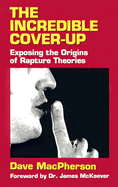So I’ve been reading reviews of the new film Left Behind. I’m surprised that Nicky Cage agreed to star in it. The reviews are beyond horrible.
A 3% by critics on Rotten Tomatoes as of this writing.
Words like “horrible” . . . “awful” . . . “laughable” (not in a good way) . . . and “this movie does no favors for Christians.”
Beyond the horrible script — according to most movie critics (what’s new, it’s a “Christian” movie, so to speak) — the whole premise isn’t even biblical.
Rapture Fever
Many Christians, especially those who live in America, are obsessed with the second coming of Christ. Various interpretations surrounding the when, where, and how of this incredible event have spawned endless divisions among Jesus’ followers.
In fact, some Christians are so fixated on the second coming of Christ that they haven’t given sufficient time to understand His first coming.
In our book, Jesus: A Theography, Leonard Sweet and I explored the return of Christ in a way that transcends classic interpretations. Rather than enter into the eschatological wars that have raged over the last two hundred years, we focus our attention on how the First (Old) and Second (New) Testaments harmonize in telling us what God has in store for the future as it concerns His Son.
That part of the book changed the minds of countless Christians when it comes to the rapture. (I don’t believe anyone one who made the Left Behind film read the book — cough.)
In it, Sweet and I showed — convincingly — that there is a “catching away” into the air as 1 Thessalonians 4 states. So the “rapture” is biblical. BUT not the way that most Christians have been taught. The catching away is a greeting to Jesus in which God’s people will meet Him in the air and then escort Him back to earth. You see, God’s game-plan has always been to bring heaven to this earth. Not to take us away from earth into heaven.
Thus His prayer, “Your will be done on earth as it is in heaven” and why the New Jerusalem — which is a huge signpost of the church — descends on the earth at the very end of the Bible.
The fact is, all the references in the New Testament about Christ’s second coming are describing the same event . . . just different aspects of it. There’s no biblical support for a two-stage coming of Jesus. In fact, that idea is very new. It originated in the 19th century.
Dave MacPherson’s book, The Incredible Cover Up, details the history of the pre-tribulational rapture theory and how it was made popular (thanks Scofield and Moody).

From Eternity to Here
As I’ve sketched out elsewhere, God’s intention from the beginning was to bring heaven and earth together. God’s purpose is to bring “eternity” to “here.”
It was to expand the garden of Eden to the rest of the world. Consequently, God’s intention is centered upon earth. God loves the earth and regards it highly. After God created the earth, the Bible says, “God saw everything that He had made, and indeed it was very good.” Contrary to what many believe, Scripture teaches that the earth will exist forever.
Although the Bible speaks of a new heaven and a new earth, the foundation of the earth will never pass away. The Lord is not going to do away with the world of space, time, and matter. Instead, God is going to renovate the earth, judge all things by fire, and burn up certain of its elements.
Some have mistakenly embraced the notion that God hates this dirty little planet and has promised to rescue His people out of it before He trashes it. But Scripture teaches no such thing. Indeed, Scripture repeatedly warns that “the world” is evil. But the Greek words translated “world” in these passages do not refer to the earth, but to the world system (kosmos) or the present age (aion) that is marked by the corruptions of sin.
The Bible makes clear that this present age is evil, that the world system is headed up by satan, and that God will judge the world system in the end. But it teaches with equal force that the earth itself is precious to God, who has wonderful plans for it. Because the world presently stands under the defilement of sin, God’s people are strangers and pilgrims to it. We are told that our citizenship is in the heavens, and we are not to be attached to that which is earthly. This present age and the world system are temporal and will pass away.
At the same time, the new creation has arrived with the resurrection of Jesus. While we are not from this world (the world system), we are certainly for the world (the earth and the people who populate it)—just as Jesus was not from this world but for it. The kingdom of God is certainly for the world, as Jesus prayed: “Your kingdom come. Your will be done on earth as it is in heaven.”
The Appearance of Jesus
Some scholars believe that Jesus never talked about His second coming. For them texts like Mark 13, Matthew 24, Luke 17, and Luke 21 all speak about Jesus’ vindication in AD 70 when the temple of Jerusalem was destroyed.
The coming of Christ will also be an apokalypsis, an “unveiling” or “disclosure.” The power and glory that are now his by virtue of his exaltation and heavenly session must be disclosed to the world.
—George E. Ladd
Other scholars believe these texts have a dual meaning. One layer of prophecy speaks of what happened in AD 70, while another layer speaks of what will happen in the future when Jesus returns to earth.
We are not going to weigh in on this debate. It is both technical and complicated, and if properly treated, it would demand an entire book of its own. Instead, we will list some of what the First and Second Testaments have to say about the Lord’s return with great consistency—when the personal presence of Jesus Christ within God’s new creation will occur:
• God will remake heaven and earth completely, affirming the goodness of the original creation and ending its corruption and finality.
• Jesus will reappear and usher in the age to come.
• When Jesus appears, those Christians who are still alive will be changed, transformed, so that their mortal bodies will become incorruptible, like Christ’s glorified, resurrected body.
• When Jesus appears, the resurrection will occur. All who have died in Christ will rise again from the dead and take on a body of immortality, just like Jesus’ glorified, resurrected body.
• The day the resurrection occurs is also called “the last day” (or “the latter day) and “the day of the Lord,” and it will come unexpectedly.
• The coming of Christ in glory, which will usher forth the resurrected, glorified bodies of the redeemed, is the Christian’s hope.
• The resurrection will occur on the “day of redemption” when our bodies will be redeemed, as well as the earth itself.
• Both the “just” and the “unjust” will rise again. And Jesus will judge both.
• The Lord will be revealed from heaven and return with thousands of His holy ones to judge the earth and show Himself to be King over all.
• In texts such as 1 Thessalonians 4, Paul used imagery from the story of Moses coming down from Mount Sinai with the Law. The trumpet sounds and a loud voice is heard. Paul also drew on the imagery of Daniel 7, in which God’s people were vindicated over their pagan enemies by being raised up to sit with God in glory.
• Jesus Christ is the omega point of creation. Upon His return, Jesus will defeat the last enemy, death. He will transform the world as the Judge. He will sum up and subdue all things to Himself. Finally, He will hand the kingdom back over to His Father, and God will become all and all.
C. S. Lewis has summed it up this way: “Unlike His first coming, Jesus’ second coming will be with power and splendour. The Bible states that everyone will see Him, and everyone will appear before Him in judgement. Simply put, He will confront every person and pronounce his or her destiny.”
The return of Christ is presented by the Second Testament authors with various rich metaphors. One is the new creation being born from the womb of the old creation. Another is the marriage of the new heavens and the new earth. Another is the kingdom of God triumphing over and swallowing up all other kingdoms.
Still another is drawn from the Roman imperial world of Caesar. The Greek word parousia is one example. When Caesar was away on a journey and he returned, his royal appearing—his imperial return to the city—was called the parousia. Caesar’s followers would go out to meet him and welcome him back to the city.
Paul used this exact language and imagery when he spoke of Christ’s return in 1 Thessalonians 4. Paul talked about meeting the Lord in the air, and how God will bring with Jesus those who have died with Him.
Putting all of the texts together on the subject, the scenario of Christ’s return perfectly fits how the Romans and Greeks understood the word parousia. Jesus will appear, the resurrection will occur, and those Christians who are alive will be transformed “in the twinkling of an eye” and meet Jesus in the air. They will then escort Him down from heaven to the newly recreated earth.
The parousia (“bodily presence,” “appearance,” “revelation,” or “unveiling”) of Jesus on earth draws all of the promises, prophecies, and unfulfilled events in both First and Second Testaments into a whole. They all come rushing together in this amazing event—an event that Luke called the “restoration of all things”—and “heaven must receive” Jesus until it occurs.
In this connection, the First Testament writers would often prophesy an event in the space of a few paragraphs, all of which have elements in them that occur thousands of years apart. So the two-part coming of Jesus, His appearance in the first century and His second coming (which hasn’t occurred yet) are stated as if they are a single event.
God’s eternal community has dawned, is dawning, and will one day arrive in its fullness. The God who has reconciled us to himself through Christ will one day bring us into full participation in the grand eschatological community of his divine reign.
—Stanley Grenz
Jesus’ Second Coming
In Scripture, the word salvation means “deliverance” and includes three tenses: we were saved (justification = salvation from the penalty of sin); we are being saved (sanctification = salvation from the power of sin); and we will be saved (glorification = salvation from the presence of sin). Salvation, then, is Jesus Christ: Christ as our righteousness (past); Christ as our sanctification (present); Christ as our hope of glory (future). The latter will occur when Jesus “will appear a second time.”
In this way, Jesus will complete what He began at His first appearing. He will end the exile. He will complete the exodus. He will bring His people and His good creation into its full rest. He will bring forth peace, justice, and prosperity to the entire world.
If we know nothing else about biblical prophecy, we know this: the fulfillment fleshes out the details. Christ’s first coming contained many surprises, even among those who studied the prophecies of the First Testament. We believe the same will be true for His second coming. It will contain surprises for even the most learned biblical scholars. In this regard, we agree with Karl Barth, who said, “We can’t fathom the Second Advent of Jesus Christ, and we stammer when we try to speak of it.”
In Philippians 3:20, Paul told the believers in Philippi that their “citizenship is in heaven.” The meaning is not that their destination was heaven. Philippi was a Roman colony. Most of the Philippians were Roman citizens.
Their destiny, therefore, was not Rome. The function of a Roman colony was to bring the culture of Rome to the city of Philippi. Thus Paul’s word to the Philippian Christians was this: “Bring the culture of the heavens to earth.”
So our calling as disciples is to labor for the kingdom of God by announcing in the power of the Holy Spirit that Jesus of Nazareth is Savior and Lord in both word and deed, praying and living that God’s will be done on earth as it is in heaven, and holding in our hearts the words of Paul and John:
“Maranatha . . . Come, Lord Jesus!”
The above is an excerpt from chapter 16 of Jesus: A Theography, “The Return of the King.” That chapter is the only place where I’ve ever addressed the issue of Christ’s second advent in any detail. The endnotes in the chapter contain documentation and sources. Those endnotes are removed from this article.
The chapter covers the following:
* The recent origins of the pretribulational two-stage return of Jesus.
* The consistent use of “The Day of the Lord” from Old to New Testaments.
* The Feasts of Israel and how they foreshadow Christ’s first and second coming.
* What the Bible says will happen when Jesus returns.
* How the second coming of Christ affects your life today.













